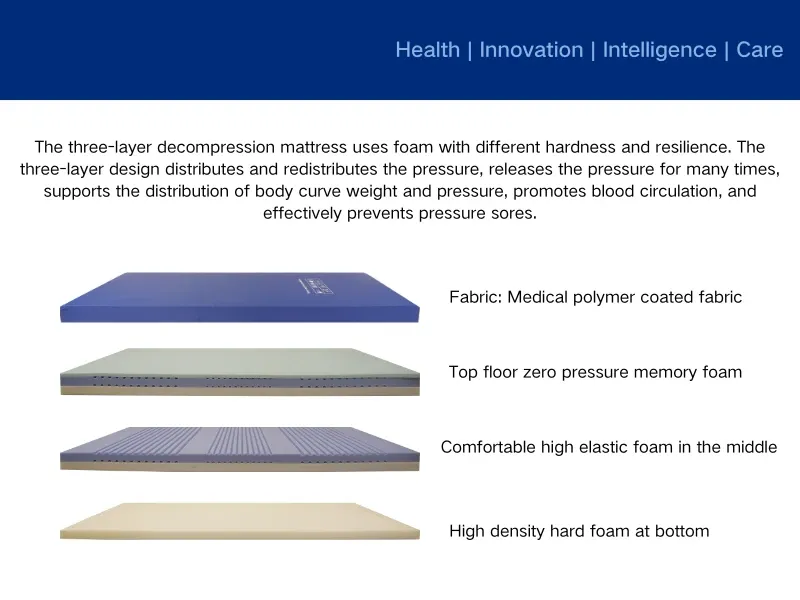Maintaining Hygiene and Safety: The ICU Nursing Silicon Mattress Advantage
In intensive care units (ICUs), patient safety and hygiene are paramount. The choice of a hospital mattress can significantly impact infection control, pressure ulcer prevention, and overall patient recovery. Among the most effective solutions available today are silicon mattresses, particularly silicone gel mattresses, which offer superior hygiene, durability, and therapeutic benefits. Unlike traditional foam or air-based alternatives, silicone bed mattresses provide a seamless, non-porous surface that resists bacterial growth while ensuring optimal pressure redistribution. This makes them an ideal choice for ICU bed mattress applications, where immobile patients are at high risk of infections and pressure injuries.

Superior Hygiene: Why Silicone Mattresses Excel in Infection Control
One of the biggest challenges in ICU settings is preventing healthcare-associated infections (HAIs). Standard hospital mattress materials, such as polyurethane foam, can harbor bacteria, fungi, and viruses within their porous structures. In contrast, silicon mattresses, especially those made with silicone gel, feature a smooth, impermeable surface that prevents microbial penetration. This allows for thorough disinfection between patients, reducing cross-contamination risks. Studies have shown that silicone bed mattresses can decrease bacterial colonization by up to 90% compared to traditional materials, making them a preferred choice for ICU bed mattress setups in infection-sensitive environments.
Pressure Injury Prevention: How Silicone Gel Mattresses Protect Vulnerable Patients
ICU patients often remain immobile for extended periods, increasing their risk of pressure ulcers (bedsores). A silicone mattress with viscoelastic properties adapts dynamically to a patient’s body, distributing weight evenly and minimizing pressure points. Unlike standard hospital mattress options, silicone gel mattresses maintain consistent support without bottoming out, even under prolonged use. This is crucial for ICU bed mattress applications, where patients may be unable to shift positions independently. The gel’s temperature-regulating properties also help maintain skin integrity by preventing excessive heat buildup, a common contributor to tissue breakdown.
Ease of Cleaning and Maintenance in Critical Care Environments of Silicone Mattress
Maintaining a sterile ICU environment requires mattresses that can endure aggressive disinfection methods. Silicone mattresses excel in this regard, as their non-absorbent surfaces can be wiped down with hospital-grade disinfectants without degrading the material. Unlike fabric-covered hospital mattress alternatives, silicone bed mattresses do not trap fluids, bodily secretions, or cleaning residues, ensuring a consistently hygienic surface. This ease of maintenance is particularly valuable in ICU bed mattress applications, where rapid turnover and strict sanitation protocols are mandatory.
Enhanced Patient Comfort and Clinical Outcomes of Silicone Mattress
Beyond infection control and pressure relief, silicone gel mattresses contribute to overall patient comfort, which is vital for recovery. The cushioning effect of a silicone mattress reduces discomfort associated with prolonged bed rest, improving sleep quality and reducing agitation in critically ill patients. Additionally, the hypoallergenic nature of medical-grade silicone minimizes skin irritation, making silicone bed mattresses suitable for patients with sensitive skin or burns. In ICU bed mattress scenarios, where patient stability is crucial, these comfort benefits can translate into better clinical outcomes and shorter recovery times.
Regulatory Compliance and Safety Standards for ICU Mattresses
Healthcare facilities must adhere to stringent regulations regarding medical equipment, including hospital mattress safety and efficacy. Silicon mattresses designed for ICU use typically meet or exceed international standards for flammability, chemical emissions, and infection control. Silicone gel mattresses are often classified as medical devices, undergoing rigorous testing to ensure they support patient care without introducing additional risks. This compliance makes them a reliable choice for ICU bed mattress deployments, where regulatory scrutiny is highest.
Future Innovations in ICU Mattress Technology
The evolution of silicon mattresses continues with advancements in smart monitoring and responsive materials. Emerging silicone gel mattress designs incorporate embedded sensors to track pressure distribution, patient movement, and even early signs of skin breakdown. These innovations could revolutionize ICU bed mattress functionality, providing real-time data to healthcare providers and enabling proactive interventions. As hospitals increasingly prioritize patient safety and infection prevention, silicone bed mattresses with enhanced technological integration will likely become the new standard in critical care.
The Unmatched Benefits of Silicone Mattresses in ICUs
The transition from traditional hospital mattress materials to advanced silicon mattresses represents a significant leap forward in ICU patient care. With superior hygiene, pressure relief, durability, and ease of maintenance, silicone gel mattresses address the most pressing challenges in critical care environments. As healthcare facilities continue to prioritize infection control and patient safety, the adoption of silicone bed mattresses in ICU bed mattress applications will only grow. Investing in high-quality silicone-based solutions ensures better outcomes for patients while reducing long-term costs for healthcare providers—making it a clear choice for modern ICUs.
-
Sleep Tracking Mattress Maintenance TipsNewsJul.22,2025
-
Mattress Wave Designs for People with ArthritisNewsJul.22,2025
-
Mattress for Back Pain and Spinal AlignmentNewsJul.22,2025
-
Hypoallergenic Properties of Silicone Gel MattressNewsJul.22,2025
-
How a Gel Memory Foam Mattress Regulates TemperatureNewsJul.22,2025
-
Doctors’ Recommendations on Special Mattress for Back PainNewsJul.22,2025
-
Customizing a Patient Bed Mattress for Specific NeedsNewsJul.22,2025

